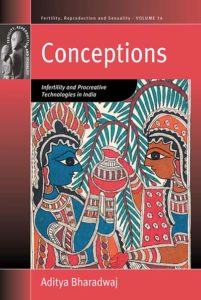Reviewed Book
Conceptions: Infertility and Procreative Technologies in India. Aditya Bharadwaj, New York: Berghahn Books, 2016, 312 pp.

What are the ways in which the infertile and their clinicians “conceive” of infertility and assisted reproductive technologies in India? In Conceptions, Aditya Bharadwaj aims to draw attention to the “cultural conceptions that lie behind the struggles of the protagonists (patients/clinicians) who feature in this research” (p. 1). In doing so, Bharadwaj elucidates the diverse social and cultural understandings at the heart of infertility and assisted reproduction in India, complicating both the biological act of conception and social ideas about infertility. This approach powerfully highlights conceptions “deemed old and new, seemingly modern and traditional” (p. 2).
Key to Bharadwaj’s ambitious work is his multi-sited approach; he effectively ties together a range of areas that “locate and animate the ‘life worlds’ of the infertile” (p. 26). His sources include ancient texts, infertile couples, families, medical practitioners, and their media representations. Spanning 15 years, Bharadwaj’s research incorporates an impressive amount of data, including interviews with more than 100 couples in six Indian cities. While Bharadwaj did not intentionally limit the study to Hindu respondents, he encountered only Hindus in some 20-odd clinics. Consequently, religion emerged as a central concern in the research, and religious and cultural themes are interwoven throughout the book.
The book is organized in four parts that, taken together, offer a comprehensive cultural account of assisted conception in India. Part I focuses on human reproduction in the Hindu worldview, drawing on ancient texts to illustrate how the Hindu community copes with infertility. Here, Bharadwaj evocatively illustrates how deeply rooted cultural ideas are about infertility in India; this analysis leads to an examination of gender and stigma in relation to infertility. Part II outlines the politics of assisted conception in India, tracing the historical trajectory of assisted reproduction in India, detailing the ways in which scientific “facts” are reported and constructed in the context of the birth of the first test-tube baby in India, and analyzing the development of assisted reproduction in relation to private and public health care in India. Parts III and IV, which examine how infertile couples and medical practitioners make sense of reproductive technologies within families and in the clinic, form the ethnographic heart of Bharadwaj’s work.
Perhaps the greatest strength of this work is Bharadwaj’s ability to lucidly weave together analyses of diverse texts, media representations, detailed field notes and observations, and ethnographic interviews to provide a thorough and thought-provoking overview of infertility and assisted conception in India. Bharadwaj’s fascinating analysis of ancient textual sources in Chapter 1 provides much needed context to social attitudes toward infertility in India, highlighting notions of purity, personhood, and gender. The book’s later chapters offer rich ethnographic evidence of the ways in which distress and suffering are viewed and experienced in the context of assisted conception. Particularly eye opening was Bharadwaj’s detailed analysis of the space of the clinic, based on his observations in the clinic lobby or waiting area, the “focal point” of the IVF clinic in India. However, although the book’s four parts fit together well on a conceptual level, the various chapters tend to traverse topics and scales in a somewhat disjointed fashion. The book clearly offers important observations about family and kinship, state and citizenship, market and clinic, to name but a few, but covering so many subjects at times obscures and weakens the overarching argument.
Bharadwaj’s emphasis on the “cultural conceptions” that underline complex experiences of infertility and assisted reproduction in India is a major strength of the book. But his arguments could have been further strengthened had he incorporated critical medical anthropological perspectives that interrogate power, inequality, and political economic factors that influence access to assisted reproductive technologies. While the frame of cultural conceptions indeed offers much needed perspective on India’s fertility markets, many of Bharadwaj’s arguments beg deeper critical analyses of broader societal relationships and inequalities. What are the infertility experiences of those who do not or cannot afford to access procreative technologies? How do couples’ economic status and caste identity, among other factors, influence experiences of stigma and infertility?
In Chapter 2, for instance, Bharadwaj offers a keen and careful analysis of the ways in which gender influences the stigma experienced by the infertile. Yet a similar analysis of the nuances and complexities of stigma and infertility in relation to caste identity and class position was missing; instead, Bharadwaj simply states that even for the upper class, “social markers of caste and class … do not safeguard against social stigma and disablement” (p. 78). Though Bharadwaj vividly describes the financial costs of assisted conception and the plight of couples from a range of socioeconomic backgrounds in Chapter 7, again, I would have appreciated a deeper analysis of the socioeconomic and caste backgrounds of these couples to account for the role of power and authority in structuring how different individuals engage in reproductive science and technology.
These concerns notwithstanding, Conceptions is a fine volume that makes a strong contribution to the growing literature on infertility and assisted reproduction around the globe, particularly in non-European American sites. In drawing on a wide range of sources and methodologies, this book offers new analytical insight into the cultural conceptions that structure the process of test-tube baby making. This book will be especially valuable to scholars of gender, reproduction, and South Asia, and would make a useful addition to reading lists for graduate- or upper-level undergraduate courses.